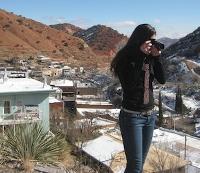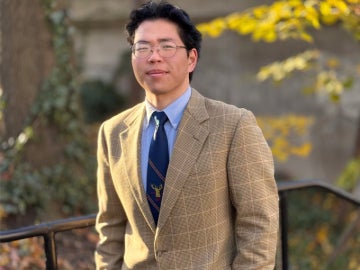Delving Into Arizona's Mining History
February 20, 2013
Paris Achenbach

Achenbach overlooks the town of Bisbee, Arizona.
Photo credit: Paris Achenbach
At Oberlin, the period between fall and spring semester known as winter term is an opportunity for growth, reflection, and new experiences. Throughout the month, formal classes are suspended, and students have the option of completing a project of their choice for half or full credit. Regardless of the project, the central objective of winter term is to continue the process of personal and academic discovery outside the confines of a classroom.
During winter term, you could often find me hundreds of feet down an old mining shaft, dressed in a blue hardhat and a yellow rain jacket taking a tour of a historic mine somewhere in Arizona. But unlike the tourists I found accompanying me, I was doing this as a part of an over-arching photojournalism project on the impact of copper mining across the state.
The idea stemmed from a seminar I took last year with Professor of Geology Bruce Simonson called “Ore Deposits,” where I learned what constitutes an ore, how they form, what the mining industry has done to extract that ore, and how it affects the surrounding landscape, communities, economy, and environment.
The eerie similarities between open-pit mining and other environmental issues — such as groundwater depletion or mountaintop removal for coal — became apparent to me, and I also realized that mining issues are often overshadowed in the media by such “hot” environmental topics. That, and the fact that I had never before seen a mine, gave me the idea to travel to mines for winter term. I could use my background as a geology major to understand the mining practices, and simultaneously gain experience in photography and journalism skills for my aspiring science-writing career. And what better place to go than Arizona, a state chock-full of mines and geologists?
That’s how I found myself on that old mine cart, lurching its way through a mining tunnel in the Mule Mountains in Bisbee, only eight miles from the Mexican border. On the tour, we learned about the dangers miners faced as they blasted rock by candlelight in the late 1800s when the mine was first developed. After taking what felt like hundreds of blurry photos (and a couple that actually turned out), I also got my first taste of how difficult it is to photograph something as dark and cramped as an old mine shaft.
Once my eyes re-adjusted to the bright world outside of the mines I visited, I would explore the town and interview locals. One of these towns was Bisbee, something of an anomaly in Arizona. Hosting several of the biggest historical mines in the state, it’s also home to liberal artists, hippies, hitchhikers, and people who want to “live off the grid.” What was once an industrial and corporate town has turned into the opposite — full of galleries, vegan restaurants, and bed and breakfasts. But while Bisbee has a neighborhood coffee shop, it’s still right next to the mile-wide copper mining pit, sitting on top of soil contaminated with heavy metal toxins.
A town similar to Bisbee and the next stop on my trip was Jerome, which had open-pit mining from 1883 to 1953. Once again, this former mining and commercial hub replaced its mines with small art galleries, boutiques, homemade candy shops, and historical museums. With its precariously perched setting on the crumbling cliffs of Cleopatra Hill, Jerome has a quasi-Italian feel, if Italian towns featured more open-pit mines and fewer gelaterias.
While visiting these towns, I had the opportunity to interview dozens of people — community members, mining geologists, and even a vice president for Freeport-McMoRan Copper & Gold Inc., an international mining company. One of my biggest surprises, more so than finding crazy hippies and artists in historic mining towns, was how generous these people were with their time and knowledge. I learned that many mining geologists don’t go into it for the money, like I sometimes expected, but became invested in geology for similar reasons to myself: an interest in how the Earth has changed over time, a love for the outdoors, and perhaps a passion for a dorky rock collection.
The rest of my time was spent all over the state, visiting towns like Phoenix, Tucson, Sedona, and Flagstaff. I was road tripping, camping, and hiking all over the place. And even when I wasn’t consciously working on my project, it seemed to find me. I was constantly taking photos, and on two separate occasions — once on a trail weaving its way through cacti in Suguaro National Park and again on an icy path up Thumb Butte Mountain in Prescott — I came across old copper exploration sites that today don’t look like much more than ditches.
My winter term left me with a mishmash of quotes and ideas from various pro-mining, anti-mining, and apathetic-mining folk. By putting myself out there and having no inhibitions in asking a million questions and taking photographs, I walked away with a wealth of ideas and information. I learned I can’t approach mining issues solely from an environmentalist and liberal perspective, or just a consumerist and geologist perspective — like the earth the miners dig in, there are many layers to the issue.
Before I left, I thought I knew what story I would find: one about the bleak and dangerous consequences of mining in America. But what I found was far more nuanced and complicated, and this semester will be spent working on articulating that story for a campus publication.
Although my trip to Arizona left me with more open-ended questions than answers, it also gave me one thing for certain: a confidence in my ability to go out into the world, talk to strangers, find a story, and write it. It’s discoveries like this one that winter term is all about.
You may also like…
Learning by Teaching: Oberlin Students Share Global Music with Young Learners
College and Conservatory students in PACE 103 prepare local children for an immersive community concert at Oberlin.
Nuiko Wadden ’02 Joins Oberlin Conservatory Faculty as Assistant Professor of Harp
The versatile musician brings extensive opera, orchestral, and contemporary music experience to her role
Leo Hidy ’23 Earns 2026 Marshall Scholarship
Leo Hidy ’23, a comparative American studies major who also studied business and economics while at Oberlin, has received a 2026 Marshall Scholarship that will fund two years of graduate study in the UK.


